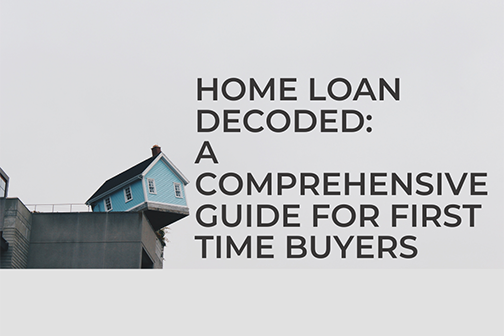The economic crisis triggered due to the Pandemic has made a large part of the population, especially the millennials, realize homeownership’s value. The real estate price stability and significant builder discounts are compelling. It makes the idea of home buying preferable, either for a living or for investment purposes. With an estimated CAGR of around 22 percent through 2026, the home loan market is growing exponentially. The lucrative low-interest rates and RBI moratorium are enticing to consider home loans to build/buy a home, you can call your own.
In India, settling down is synonymous with homeownership and is an indicator of financial stability. It’s a quintessential dream, but how realistic? Is it an undaunting and straightforward to opt for a home loan, as it looks like? The answer would have been murky a few years ago, but fortunately, obtaining home loans are now affordable and achievable, more than ever. It can be attributed to the financial institutions offering various housing loan schemes to cater to varying requisites of different sections of society. If you are looking for a home loan, then here are the most popular types of home loans to consider:
1. Purchasing Home Loan
The most common type of housing loan is to purchase a residential property, including a flat or bungalow, or row house. Bank offers 80-90% of the property value, and the remainder is to be arranged by you as a down-payment.
Eligibility Criteria:
To avail of the loan, an individual, in general, should qualify for the below criteria:
| Salaried Person | Self-Employed | |
| Age | 18-70 years | 18-70 years |
| Employment | At least 2 years of experience | At least 5 years of experience |
| Credit Score | 700 and above | 700 and above |
2. Home Construction Loan
This loan is designed for individuals who own the land and prefer to construct their own home rather than a pre-constructed house. A critical clause in this type of loan is that the plot must be bought within a year for the plot cost to be included in the loan. The estimate of construction cost and relevant documents are required to get the loan sanctioned.
Eligibility Criteria:
| Salaried Person | Self-Employed | |
| Age | 18-70 years | 18-70 years |
| Employment | Atleast 1 year of experience with current employer | Available for all |
| Credit Score | 700 and above | 700 and above |
3. Home Improvement Loan
Renovation, beautification, and repair can change your house’s look. Still, if you lack finances, then banks have specialized home improvement loans. These types of loans are offered at attractive interest rates, and on the contrary, you are not required to shell out the entire amount from your pocket.
Eligibility Criteria:
| Salaried Person | Self-Employed | |
| Age | 18-70 years | 18-70 years |
| Employment | Available for all salaried individuals. | Available for all |
4. Land Purchase Loan
The name of the loan says it all! Many banks offer loans to purchase land where one plans to construct a home or have it as an investment.
Note: Buying agricultural land is not allowed under this loan.
5. Home Extension Loan
Want to add another balcony or new floor or bedroom? Home loan expansion or extension offered by banks is widespread in this category.
A home loan is not a one-time decision. Hence, you should review all the markets and compare all the variables before signing the home loan agreement’s dotted line.
Unique Features Of Home Loan:
- Eligibility: Healthy credit score, repayment capacity, and property value are three crucial aspects of home loan consideration.
Note:- Most banks calculate the EMI amount to be about 50% of your disposable income for repayment.
- Repayment capacity depends on the income, and the last 3 yrs of ITR is considered. Higher monthly income leads to a higher loan amount.
- An ideal credit score of 750 or more is eligible to get home loans at low-interest rates as they are less of a liability for banks.
- Loan Amount: Bank finances 80-90% of the property value, and the remaining 10-20% down-payment (margin money) should be mobilized by
- Interest Rate: The loans are linked to the Marginal Cost of Lending Rates (MCLR).
What is MCLR?
It is the minimum interest rate that a bank can lend at and avail the benefits of the RBI bank’s rate cuts. A hike or cut in Repo Rate by RBI affects MCLR. Banks will need to follow the same suit to correct the lending rate. The cost of borrowing the funds are of two types: fixed and floating.
- Fixed-rate: A fixed interest rate remains constant throughout the tenure of the home loan.
- Floating rate: The floating rate is linked with the apex bank interest rate and changes from time to time as per market conditions. In the current market scenario, floating-rate loans are highly recommendable as a downward trend is expected in the future. If there is a cut in the repo rate, the lender will reduce the floating rate proportionately.
4. Security: A home loan is a secured loan that requires collateral. Usually, the home itself acts as collateral for the loan borrowed.
5. Loan Tenure: Home loans are generally sanctioned upto 30 years. A short tenure loan has a high EMI, whereas a longer tenure loan has a low EMI. Even though low EMI is the preferential choice, opt for short-term tenure loans as the total interest payout is lesser. This example highlights the difference:
| Amount (INR) | Amount (INR) | |
| Loan Amount | 40 Lakhs | 40 lakhs |
| Interest Rate | 6.75% | 6.75% |
| Tenure | 15 years | 20years |
| EMI | 35,396 | 30,415 |
| Total Interest |
23,71,348 | 32,99,494 |
Change in tenure from 15 years to 20 years, the total interest payout increases by 14%. It shows that short tenure loans are better. Nevertheless, choose the right balance between EMI and tenure that suits your financial requirements.
6. Other Costs: You don’t just pay EMI, but there are several additional charges that banks often brush off under the carpet. Banks probably consider them small amounts compared to the loan, but here’s the catch- they aren’t negligible.
Here’s why: Mr. A applied for a loan of Rs. 2 Cr for 10 years at 8%. After 2 years, he was yet to pay Rs. 1.6 Cr and decided to switch from a fixed rate to a floating-rate loan. In the process, he was astonished to incur other costs or hidden charges of Rs,70,000.
Banks usually charge a processing fee of about 0.5% -1% of the loan amount separately. Other charges include documentation fees, late fees, conversion fees, legal expenses, and more. However, many of these fees are negotiable, and banks do waive them off.
7. Insurance: A home loan is a long-term commitment. A borrower needs to fulfill financial liability in all instances. Home loan insurance ensures to cover the family’s interests in unforeseen events like death or disability before loan repayment. Though not compulsory, it is in the best part of loved ones.
8. Tax Benefits: To boost the goal of ‘Housing for All’ affordable housing, the government provides various tax benefits.
| Sections in the IT Act | Nature of home loan deductions | Maximum amount deductible | Conditions |
| Section 80 C | Principal Repayment | Rs,1.5 lakh | House property should not be sold within 5 years of possession |
| Section 24B | Interest Repayment | Rs. 2 lakh | The loan must be taken to purchase the house and construction should be completed within 5 years starting from the end of the financial year in which the loan was taken. |
| Section 80EE | Interest | Rs.50,000 | The loan amount must be Rs.35 lakh or less and the property’s value must be within 50 lakhs. |
| Section 80EEA |
Interest | Rs.1.5 lakh |
The stamp value of the property must be upto Rs.45 lakh and the loan to be sanctioned between April 2019 to March 2021. One cannot claim tax deduction u/s 80EE. |
FAQs on Home Loan:
Here, you’ll find answers to questions that frequently crop up during our free counseling sessions-
Does it help to pre-pay a loan? What are the prepayment charges?
Most people make part or full prepayment of loans when they have surplus money. It reduces the outstanding principal amount, and interest is calculated on the reduced principal. Alternatively, consider the Home Saver or Maxgain option. It allows you to deposit surplus savings in the bank account and pay interest on the home loan only, which is the net difference between the two.
Banks are exempted from charging any prepayment penalty on floating rate loans. In contrast, there may be a charge on fixed-rate loans. It may vary from 1 % to up to 3% of the loan amount.
Is it mandatory to have a co-applicant?
Yes, mostly all banks require a co-applicant. A co-owner can be a co-applicant, and any immediate family member can be a co-applicant in the case of a sole owner.
Pro Tip: If your required loan amount is more than the maximum loan eligibility, add three earning members of the family as co-applicant to increase the eligibility.
Can I take a new home improvement loan with the existing home loan?
Banks offer ‘top-up loans’ that can be available time and again depending on the property’s income and value.
For sanctioning a home improvement loan, the borrower will have to submit the work’s cost estimate to be done to the bank. The bank will take a quotation from the contractor to verify the cost estimates. The loan is then disbursed based on the progress of the construction work.
Can I opt for a balance transfer facility?
Most banks provide transfer facilities on the home loan balance. With the prepayment charges being waived off (only on floating rate), you may transfer the outstanding loan amount to a new lender with a lower interest rate.
Does my home loan cover stamp duty and registration fee?
No, they are excluded from the home loan sanction and are an out-of-pocket expense. Generally, the cost of stamp duty is 5-7% of the property’s market value. Registration charges are subject to 1% of the property’s market value.
How can I pay my home loan EMI?
There are different modes for loan repayment – standing instructions to the bank to pay installments via ECS, direct deductions of EMI by your employer, or issue post-dated cheques.
Home loans are a boon to people who cannot afford to pay in full but still want to own a home. Opt for legitimate banks or NBFCs for home loans, that will make the process seamless and secured. Home loans are increasingly becoming a preferred choice, not only for the satisfaction of having a place of your own, but as a viable financial option to back you during to uncertainties such as COVID-19,




